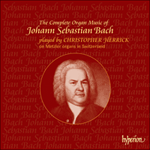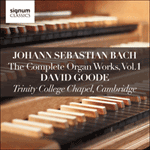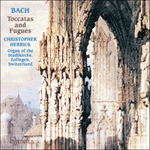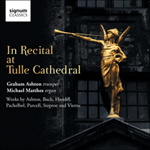
Welcome to Hyperion Records, a British classical label devoted to presenting high-quality recordings of music of all styles and from all periods from the twelfth century to the twenty-first.
Hyperion offers both CDs, and downloads in a number of formats. The site is also available in several languages.
Please use the dropdown buttons to set your preferred options, or use the checkbox to accept the defaults.

The strict counterpoint of a fugue is often regarded as the most complex part of the toccata-fugue form, but the dramatic opening of the Toccata and Fugue in D minor is such that one feels an enormous sense of arrival, perhaps even release, when the Toccata finally gives way to the Fugue. The opening is one of the most recognizable motifs in the classical music repertoire: three notes in octaves (A-G-A) cascade downwards, arriving finally on a low sustained pedal D from which emerges a diminished C# chord creating such dissonance (for the time) that seems to resolve only just before becoming questionable. Such timing, this has to be one of the most spectacular openings in the organ repertoire. As mentioned, the arrival of the fugue gives an enormous sense of release as gently flowing sixteenth notes drift calmly by, before casually moving aside to accommodate the second sub-dominant voice. Sublime musical logic: it is no wonder Johann Sebastian Bach is considered one of the greatest of all baroque composers.
from notes by Graham Ashton © 2011
Le contrepoint strict d’une fugue est souvent considéré comme la partie la plus complexe d’une forme alliant toccata et fugue, mais les premières mesures de la Toccata et Fugue en ré mineur sont si spectaculaires que l’on éprouve un sentiment prodigieux d’aboutissement et peut-être même de soulagement lorsque la Toccata cède le pas à la Fugue. Cette attaque offre l’un des motifs les plus identifiables du répertoire de la musique classique: trois notes en octaves (la-sol-la) s’égrènent en cascade, pour aboutir à un ré grave soutenu au pédalier qui se transforme progressivement en accord de do dièse diminué, créant une dissonance choquante pour l’époque qui semble se résoudre juste avant de devenir douteuse. La cadence étonnante de ce début en fait l’un des plus spectaculaires de tout le répertoire de l’orgue classique. Comme nous l’avons mentionné plus haut, l’arrivée de la fugue apporte un grand soulagement lorsque les doubles croches s’écoulent doucement et calmement, avant de s’écarter nonchalamment pour laisser place à la seconde voix sous-dominante. Cette musique est d’une logique sublime : il n’est pas étonnant que Johann Sebastian Bach soit considéré comme l’un des plus grands compositeurs de toute la musique baroque.
extrait des notes rédigées par Graham Ashton © 2011
Der strenge Kontrapunkt einer Fuge gilt oft als der komplizierteste Teil der Toccata- und Fugenform, aber bei dem dramatischen Anfang der Toccata und Fuge in d-Moll hat man ein enormes Gefühl der ‚Ankunft‘, vielleicht sogar der großen Erleichterung, wenn die Toccata schließlich der Fuge weicht. Die ersten Takte sind eines der bekanntesten Motive im klassischen Musikrepertoire: drei Noten in Oktaven (A-G-A) stürzen bis zu einem tiefen, anhaltenden, mit Pedal gespielten D hinab, aus dem ein verminderter Cis Akkord hervorgeht, der eine für jene Zeit derartige Dissonanz erzeugt, dass er sich erst aufzulösen scheint, bevor er fast nicht mehr zu tolerieren ist. Dieses ‚Timing‘ kreierte eine der spektakulärsten Anfangspassagen im Orgelrepertoire. Ähnlich vermittelt das Einsetzen der Fuge durch die ruhig dahingleitenden Sechzehntelnoten ein enormes Gefühl der Befreiung, bevor sie ganz unvermerkt der zweiten Subdominantstimme Platz machen. Eine unvergleichliche Logik der Musik: kein Wunder, dass Johann Sebastian Bach als einer der größten Barockkomponisten gilt.
aus dem Begleittext von Graham Ashton © 2011
 Bach: The Complete Organ Works Bach: The Complete Organ Works‘Let me say without hesitation that Herrick’s performances are models of clarity, accuracy, precision and musicality … this is a complete Bach th ... ‘Herrick is one of the few organists who does justice to these difficult, elusive pieces … What a singular joy to hear the organ played with such ...» More |
 Bach: The Complete Organ Works, Vol. 1 Bach: The Complete Organ Works, Vol. 1A grand new series on Signum will present the complete organ works of Johann Sebastian Bach in crystal performances from David Goode on the 1976 Metzler organ of Trinity College Cambridge.» More |
 Bach: Toccatas and Fugues Bach: Toccatas and Fugues‘Stupendous organ sound … one of the three Bach CDs I will turn to over and over again for sheer enjoyment’ (Gramophone) ‘If you only have one disc of organ music in your collection this must be it’ (The Good CD Guide)» More |
 In Recital at Tulle Cathedral In Recital at Tulle CathedralAn exceptional programme from two consummate performers, blending new arrangements of classical and baroque works with the premiere recording of Roger Steptoe’s Sonata for Trumpet and Organ./p>» More |

